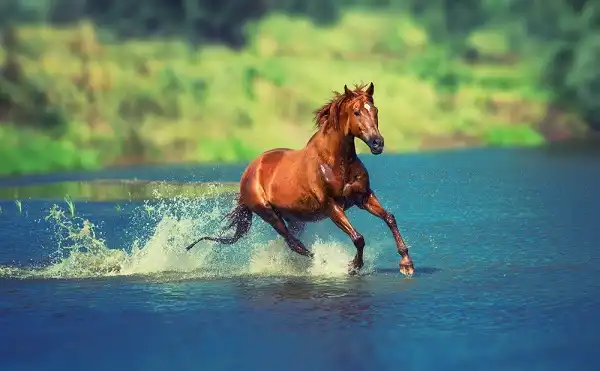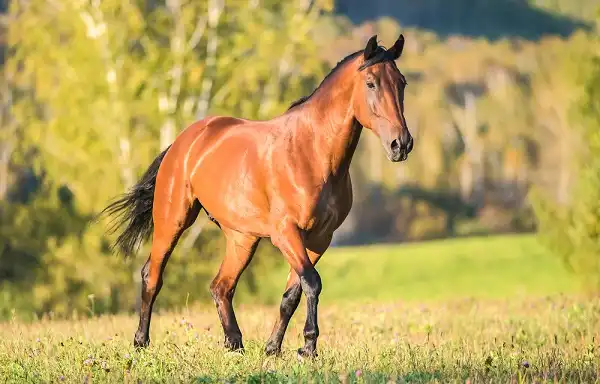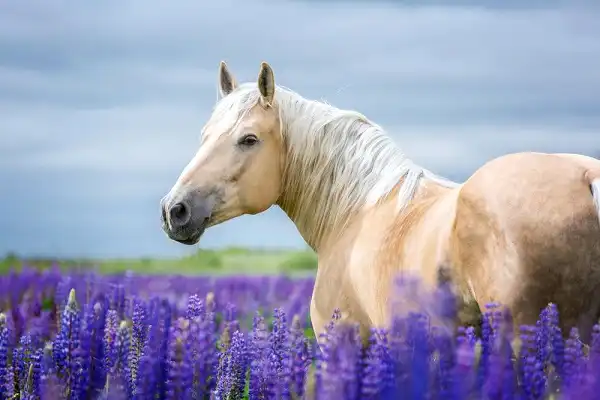Are you fascinated by the majestic essence of horses? From their stunning beauty and powerful strides to the loving bond experienced between horse and rider, it’s easy to see why these magnificent creatures continually captivate us. Horses have been a part of society for centuries, playing an influential role in various aspects of life such as transportation, agriculture, warfare during certain historical eras, and more! In this blog post, I’ll take you through all things relating to equines; from fun facts about horse breeds & anatomy to exploring how they’ve made their mark on our culture. So if you’re eager to learn more about nature’s most elegant four-legged friends then read on – let us begin our journey into the delightful world of horses!

Horse Description
Horses are large domesticated mammals known for their power, speed, and elegance. They possess a unique blend of grace and strength that is captivating and awe-inspiring. Their muscular bodies are designed for speed and agility, with long, slender legs ending in hard hooves that can withstand tough terrain. A horse’s body is covered with a coat of short, glossy hair that varies in color from black, brown, and white to golden, chestnut, and beyond. The mane and tail are typically longer and can be either straight or wavy. A horse’s head is long and pointed, with large, expressive eyes, and ears that swivel to pick up sounds from all directions. Truly, the horse is a creature of remarkable beauty and majesty.
Horse Habitat
Horses can be found in a wide variety of habitats around the world, showcasing their adaptability and resilience. In their wild state, horses generally prefer open terrains such as prairies and steppes where they can graze freely and have a clear line of sight to spot any potential predators. Wild horses are known to inhabit the grasslands of North America, the deserts of Australia, and the steppes of Asia, proving their ability to thrive in diverse climatic conditions. When domesticated, horses are housed in stables or pastures providing them with adequate shelter, food, and room to exercise. A horse’s domestic habitat needs to be safe, clean, and comfortable. This includes a well-constructed stable or barn to protect the horse from harsh weather conditions, a sizeable pasture for grazing and running, and a clean, dry area for lying down.
Horse Diet
Horses are herbivores, and their diet primarily consists of grasses, legumes, and grains. In the wild, horses spend the majority of their time grazing, consuming various types of grasses and plant materials available in their habitat. The type of forage they consume can vary depending on the season and the region they inhabit. Their long, pointed teeth are designed for tearing grasses, while their large, flat molars are perfect for grinding plant material, preparing it for digestion. In a domestic setting, a horse’s diet is carefully monitored and controlled to ensure they receive all the necessary nutrients. Hay is often the main component of a domestic horse’s diet, supplemented by grains such as oats, barley, and corn.
Horse feed can also include specialized pellets that are designed to provide a balanced mix of nutrients. Additionally, horses are provided with salt and mineral licks to supplement their diet further. It’s important to note that horses have a sensitive digestive system, which functions best with frequent, smaller meals rather than large, infrequent ones. Regardless of whether they are wild or domesticated, horses need access to clean, fresh water at all times. They can drink up to ten gallons of water a day, and this amount can be higher in hot weather or when the horse is involved in heavy work.

Horse Size
The size of a horse can vary significantly depending on the breed, genetics, nutrition, and care. Generally, horse size is measured in hands, a unit of measure equivalent to 4 inches, from the ground to the horse’s withers – the highest point of the horse’s back, located where the neck meets the spine. This method provides a standard way to discuss the height of horses worldwide. In terms of height, horses can be broadly classified into three categories: ponies, horses, and draft horses. Ponies are typically less than 14.2 hands high (about 58 inches or 147 cm). They are a favorite amongst young riders due to their manageable size and friendly demeanor. “Horses” generally refer to equines that are between 14.2 and 17 hands high (58 to 68 inches or 147 to 173 cm).
This category includes a range of breeds from racing thoroughbreds to working farm horses. Finally, draft horses exceed 17 hands high and are characterized by their significant strength and sturdy build, often used for heavy work such as plowing and hauling. Weight, much like height, also varies greatly among different breeds and individual horses. On average, an adult horse can weigh anywhere from 900 to 2,200 pounds (410 to 1,000 kg). Ponies, being smaller, usually weigh between 600 and 900 pounds (270 to 410 kg). Draft horses, the largest of the lot, can weigh over 2,200 pounds.
Horse Lifespan
The longevity of horses can vary dramatically depending on factors such as breed, diet, work conditions, and veterinary care. On average, a horse’s lifespan ranges from 25 to 30 years, although it’s not uncommon for some horses to live into their 40s with appropriate care and management. The oldest recorded horse reportedly lived to the ripe old age of 62! Certain breeds, like the Arabian horse, are known for their longevity, often living well beyond the average horse’s lifespan. In the wild, a horse’s lifespan is typically shorter due to the presence of predators, harsh environmental conditions, and lack of medical care.
Wild horses have to forage for food and often face nutritional deficiencies, especially during harsh winters. Age-related ailments are also more prevalent and harder to manage in a wild setting. Domesticated horses, on the other hand, tend to live longer due to regular access to food, shelter, and medical care. A balanced diet and regular exercise play a crucial role in enhancing a horse’s lifespan. Regular veterinary check-ups allow early detection and management of diseases, further contributing to the increased lifespan of domestic horses.
Horse Behavior
Horses exhibit a wide range of behaviors that are both fascinating and indicative of their physical and emotional state. Innate to their nature as prey animals, horses are extremely vigilant and are usually found in a state of alertness, always on the lookout for potential threats. They communicate with each other through a complex system of body language, vocalizations, and mutual grooming. Body language is especially significant, with horses using their ears, eyes, nostrils, and body posture to express their emotions and intentions. For instance, a horse with its ears pinned back is often seen as aggressive or annoyed, while those with pricked forward ears are alert or curious.
They are also herd animals, preferring to live in groups for protection and companionship. The herd usually has a defined hierarchy, with a dominant horse leading the group and others following suit. Within the herd, horses establish relationships and social bonds, often exhibiting behaviors such as mutual grooming – a social activity where horses stand head to tail and groom each other, which helps to strengthen their bond. Mutual grooming is not only a social behavior but also has a practical function of reaching areas where a horse cannot easily groom itself.

Horse Speed
Horses are widely revered for their speed and agility, with different breeds exhibiting varying degrees of speed. The ability of a horse to run swiftly has been a trait that humans have valued for centuries, whether for hunting, warfare, racing, or simple transportation. The speed of a horse can range from leisurely walks to impressive sprints, and their gait – the pattern of limb movement – plays a significant role in this. Horses have four basic gaits: walk, trot, canter, and gallop, with gallop being the fastest. The Thoroughbred horse breed is particularly recognized for its speed and stamina, a trait that makes them the preferred breed in horse racing.
A top racing Thoroughbred can reach speeds of over 40 miles per hour (64 kilometers per hour), although this speed can be sustained only over short distances. Quarter Horses, on the other hand, are renowned for their sprinting capabilities. They excel in short-distance racing and are known to be the fastest breed over distances of a quarter mile or less, reaching speeds up to 55 miles per hour (88 kilometers per hour). However, a horse’s speed is not just determined by its breed. Factors such as age, fitness level, training, and rider skill can also influence a horse’s speed.
Horse Reproduction
Horse reproduction is a fascinating and complex process that begins with the mare’s breeding cycle. Mares are seasonally polyestrous animals, which means they have multiple estrous or heat cycles throughout the breeding season, typically from spring to early autumn. Mares come into heat approximately every 21 days, with the actual heat period lasting around 5-7 days. During this period, mares display signs of receptivity to a stallion, such as frequent urination, tail raising, and ‘winking’ of the vulva. Stallions, on the other hand, are capable of breeding year-round, although their fertility can be influenced by factors such as age, health, and season. Fertilization in horses occurs internally, through natural mating or artificial insemination. After breeding, the sperm travels up the reproductive tract to the oviduct, where if timed correctly with ovulation, it fertilizes the egg.
The fertilized egg, now an embryo, travels down the oviduct and into the uterus, where it will implant itself into the uterine wall and begin to grow. A mare’s gestation period is approximately 11 months, although it can vary from 320 to 370 days. During this time, the unborn foal develops within the mare’s uterus, nourished by the placenta. Birth in horses, known as foaling, is a swift and efficient process, typically completed within 30 minutes. The foal is usually born at night, presumably to avoid predators in a natural setting. After birth, foals are remarkably precocious, standing and nursing within the first couple of hours of life. The mare and foal form a strong bond, with the mare often showing protective behavior towards her foal. Understanding the basics of horse reproduction can be beneficial for horse owners and enthusiasts, providing insights into the early life of these magnificent creatures and the factors that influence their breeding and survival.
Horse Hunting
Hunting on horseback often referred to as fox hunting, is a traditional sport that dates back hundreds of years in many cultures across the globe. Historically, this sport involved the use of hounds and horses to hunt foxes, hares, and other game. Riders, usually in traditional attire, would follow a pack of hounds who were trained to track and pursue the scent of the game. The role of the horse in this activity was to carry the rider across varying terrains, jumping fences, and ditches as required. Horse hunting requires a horse breed that possesses endurance, intelligence, and agility. Some popular breeds used in hunting include the Thoroughbred, Irish Draught, and the English Foxhound. In contemporary times, horse hunting has evolved, with many hunts now operating as ‘drag’ or ‘trail’ hunts. In these hunts, instead of pursuing live games, a pre-laid scent trail is followed. This change was initiated to mitigate concerns about animal welfare while preserving the tradition and challenge of the sport. Despite the change, the demands on the horse remain the same and riders are expected to have control over their horses at all times, demonstrating respect for the countryside and wildlife.

Conclusion
Horses have left an indelible mark on human history, shaping the way societies have evolved over thousands of years. Their impressive capabilities continue to captivate us, whether it’s their remarkable speed, intricate reproductive process, or their role in traditional sporting activities like hunting. The speed of a horse is dependent on not only its breed, but also other factors such as age, fitness level, and training. Their reproductive process, involving multiple heat cycles and an internal fertilization process, is a testament to the wonders of nature. Lastly, hunting on horseback, a tradition steeped in history, continues to be an integral part of many communities, despite its evolution and controversy. As stewards of these majestic creatures, it falls upon us to ensure their welfare, understand their needs, and respect their contribution to our world.
Frequently Asked Question


